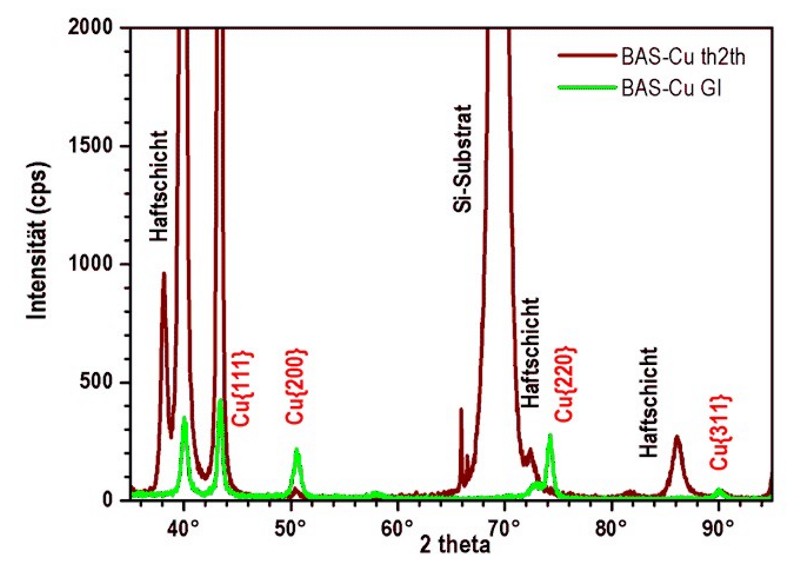X-Ray Diffraction Methods
X-Ray Diffraction
The regular arrangement of atoms or ions in a crystal lattice results in the formation of different parallel ordered group of lattice planes. At the indicdent of a bundle of X-rays on a group of lattice planes under an angle theta the single rays will be diffracted an reflected. If the path length difference of the rays equals an integer multiple of the wavelength constructive interference occurs (Bragg condition).

Phase Analysis
If the intensities of the reflected rays are plotted against the angle of the detector (2theta) a so called diffractorgram results. Therin the position of the reflexes is determined by the distance of the lattice planes. The intensities derive from the electron densities on the lattice planes. Such a diffractogram is like a fingerprint and can be assigned to a certain substance and its crystal structure.

Grazing Incidence
The information depth of a theta-2theta-measurement (th2th) is much larger than the thickness of a system of thin surface layers. Therfore most of the gathered information originates from the bulk substrate. If the incident angle is decreased the proportion of layer- to bulk-information changes in favour of the layer. Therefore an asymmetric measurement with very small, constant incident angles (Grazing Incidence: GI) provides optimal conditions for the analysis of thin layers.

Texture Investigations
The comparison data of the data bases are based on the statistical distribution of crystallites as seen in powders. If the measured distribution differs from the statistical model this can be due to a different form of the particles or due to a variation in their manufacturing process. This phenomenon is called preferred orientation or texture. The deviations of the intensities of the reflections from the model can be severe. Textures are being investigated using pole figures. The intensity of a chosen reflection is being recorded while the sample is rotated (phi) and tilted (psi). The peak widths at half-height of the recorded date are characteristic for the tilt and rotation of the crystallites. For example the occurrence of circles is distinctive for fiber textures.
Residual Stress Measurements
Thin films are a complicated subject in the sense that a change in the production process strongly affects the quality of the layers. The crystallographic structure of the substrate can define the orientation of the crystals of the film. Unmatched coefficients of thermal expansions of substrate and film cause additional stress. Layer tensions influence the adhesion of the coating. Therefore it is important to find and control them. The associated analysis investigates the variation of the position of a chosen reflection (2theta) while tilting the sample under various angles (psi). The measured data yields a sin2(psi) plot enabling the determination of compressive, tensile or shear stress.

X-Ray Reflectometry
Microelectronic devices require thin films or layer systems to feature a desired functionality. These layers usually range from 20 to 100 nm. X-ray reflectometry enables the determination of film thicknesses, densities, roughnesses not only of the top but also of buried layers. Because this method investigates layer systems instead of the crystalline structure of separate layers non-crystalline films such as SiO2 are measurable as well.


